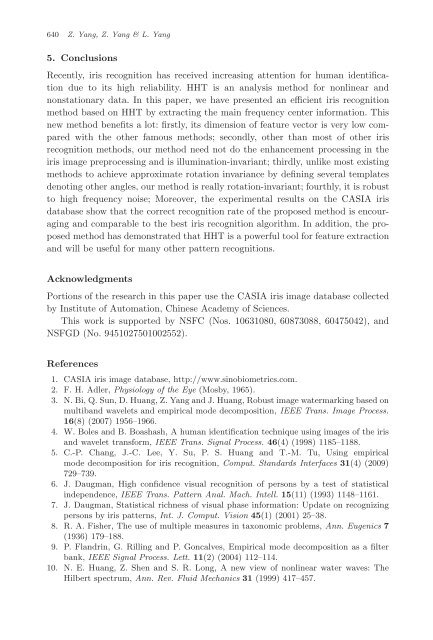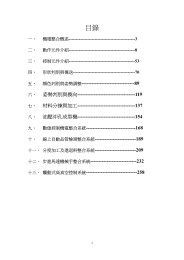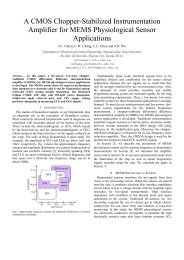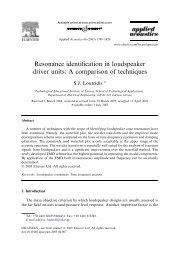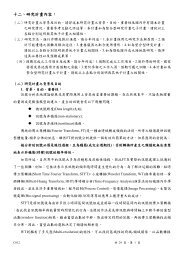IRIS RECOGNITION BASED ON HILBERT–HUANG TRANSFORM 1 ...
IRIS RECOGNITION BASED ON HILBERT–HUANG TRANSFORM 1 ...
IRIS RECOGNITION BASED ON HILBERT–HUANG TRANSFORM 1 ...
Create successful ePaper yourself
Turn your PDF publications into a flip-book with our unique Google optimized e-Paper software.
640 Z.Yang,Z.Yang&L.Yang<br />
5. Conclusions<br />
Recently, iris recognition has received increasing attention for human identification<br />
due to its high reliability. HHT is an analysis method for nonlinear and<br />
nonstationary data. In this paper, we have presented an efficient iris recognition<br />
method based on HHT by extracting the main frequency center information. This<br />
new method benefits a lot: firstly, its dimension of feature vector is very low compared<br />
with the other famous methods; secondly, other than most of other iris<br />
recognition methods, our method need not do the enhancement processing in the<br />
iris image preprocessing and is illumination-invariant; thirdly, unlike most existing<br />
methods to achieve approximate rotation invariance by defining several templates<br />
denoting other angles, our method is really rotation-invariant; fourthly, it is robust<br />
to high frequency noise; Moreover, the experimental results on the CASIA iris<br />
database show that the correct recognition rate of the proposed method is encouraging<br />
and comparable to the best iris recognition algorithm. In addition, the proposed<br />
method has demonstrated that HHT is a powerful tool for feature extraction<br />
and will be useful for many other pattern recognitions.<br />
Acknowledgments<br />
Portions of the research in this paper use the CASIA iris image database collected<br />
by Institute of Automation, Chinese Academy of Sciences.<br />
This work is supported by NSFC (Nos. 10631080, 60873088, 60475042), and<br />
NSFGD (No. 9451027501002552).<br />
References<br />
1. CASIA iris image database, http://www.sinobiometrics.com.<br />
2. F. H. Adler, Physiology of the Eye (Mosby, 1965).<br />
3. N. Bi, Q. Sun, D. Huang, Z. Yang and J. Huang, Robust image watermarking based on<br />
multiband wavelets and empirical mode decomposition, IEEE Trans. Image Process.<br />
16(8) (2007) 1956–1966.<br />
4. W. Boles and B. Boashash, A human identification technique using images of the iris<br />
and wavelet transform, IEEE Trans. Signal Process. 46(4) (1998) 1185–1188.<br />
5. C.-P. Chang, J.-C. Lee, Y. Su, P. S. Huang and T.-M. Tu, Using empirical<br />
mode decomposition for iris recognition, Comput. Standards Interfaces 31(4) (2009)<br />
729–739.<br />
6. J. Daugman, High confidence visual recognition of persons by a test of statistical<br />
independence, IEEE Trans. Pattern Anal. Mach. Intell. 15(11) (1993) 1148–1161.<br />
7. J. Daugman, Statistical richness of visual phase information: Update on recognizing<br />
persons by iris patterns, Int. J. Comput. Vision 45(1) (2001) 25–38.<br />
8. R. A. Fisher, The use of multiple measures in taxonomic problems, Ann. Eugenics 7<br />
(1936) 179–188.<br />
9. P. Flandrin, G. Rilling and P. Goncalves, Empirical mode decomposition as a filter<br />
bank, IEEE Signal Process. Lett. 11(2) (2004) 112–114.<br />
10. N. E. Huang, Z. Shen and S. R. Long, A new view of nonlinear water waves: The<br />
Hilbert spectrum, Ann. Rev. Fluid Mechanics 31 (1999) 417–457.


